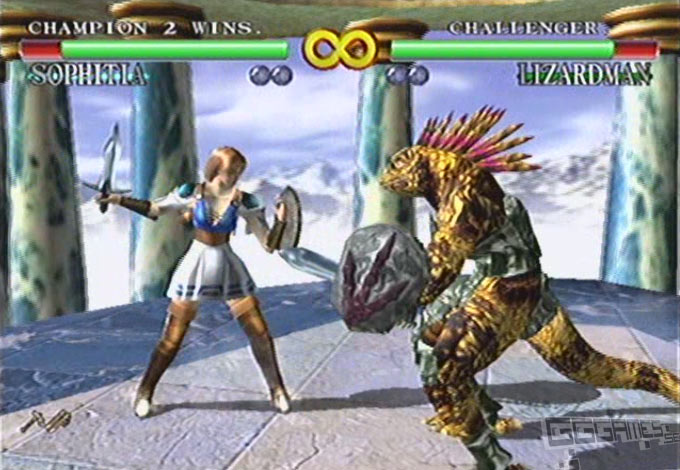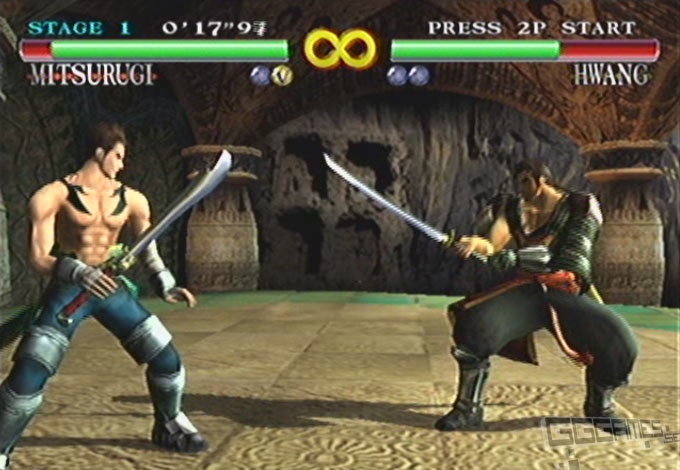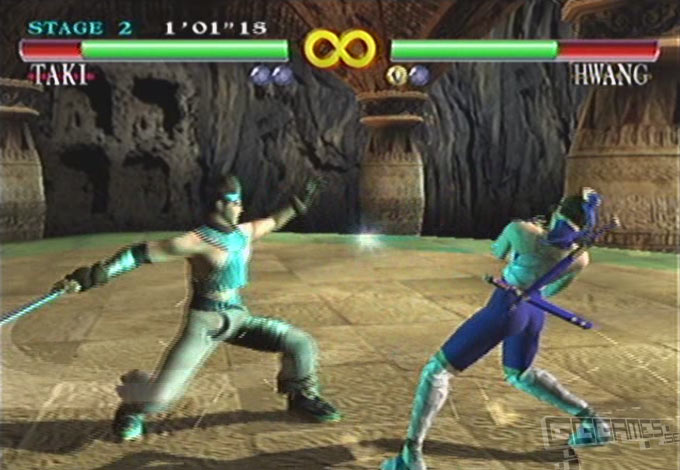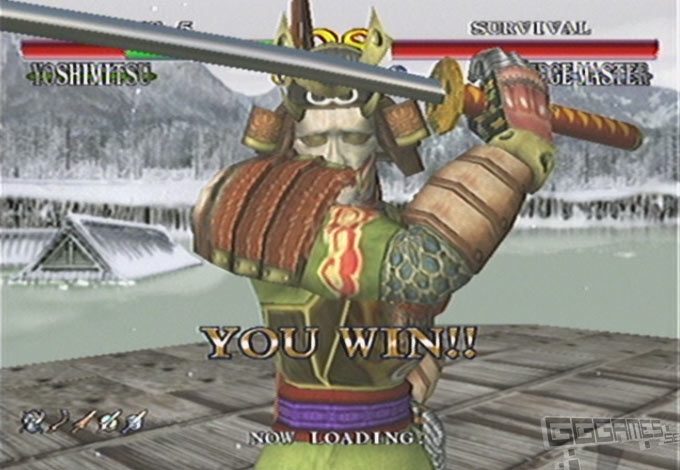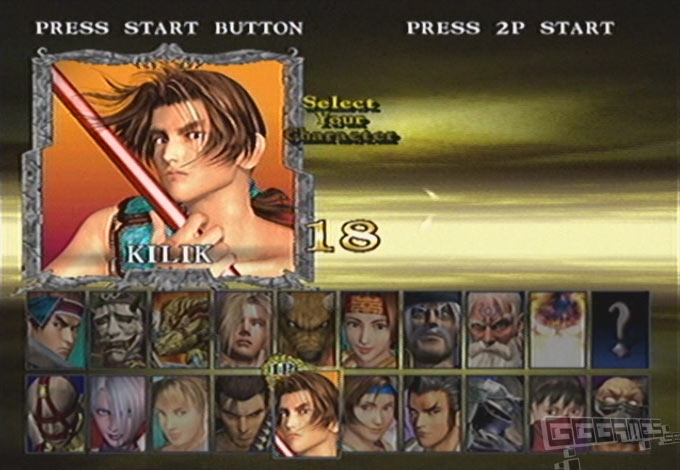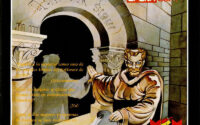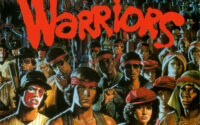SoulCalibur Review
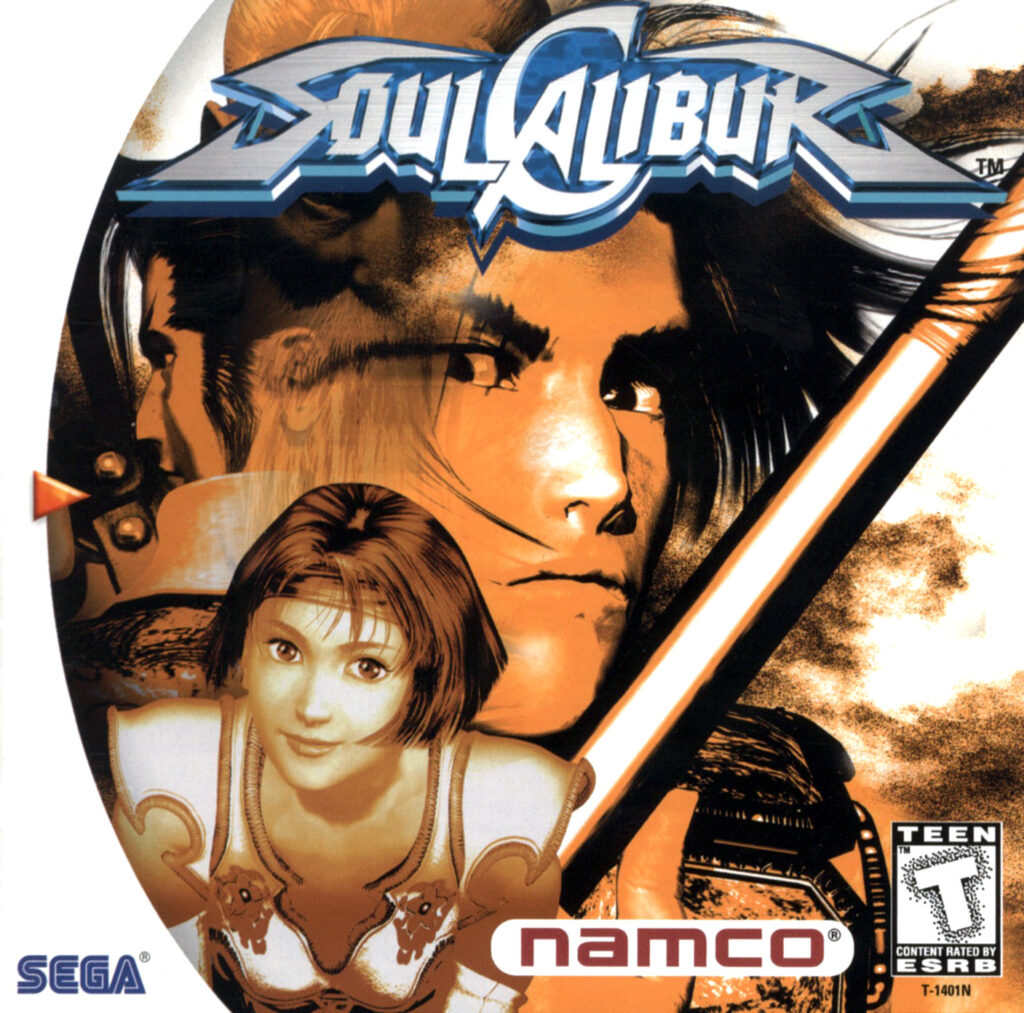
Truly epic 3D fighting with brilliant graphics, awesome music and tons of replay value.
Story
The legendary evil sword known as Soul Edge has many myths and rumors around it. The owner of the cursed sword was the dreaded pirate Cervantes whose reign of terror ended after his defeat at the hands of Sophitia, the sacred warrior and Taki the demon huntress.
However, the cursed sword was eventually found by Siegfried, a knight searching for a sword of vengeance. Several years later, rumors have started spreading about an evil azure knight who has a grotesquely misshapen hand and holding a giant one-eyed sword. The fearsome knight is said to surpass Cervantes himself in his evil.
The Game
SoulCalibur is a blazing fast one-on-one fighting game set in an alternative universe world. It is the successor of Soul Edge that was released in 1996 in the arcades and for PlayStation.
The Dreamcast version of SoulCalibur builds upon the original arcade version. It is such a rare example of where the home console version beats the arcade counterpart both graphics- and content wise.
SoulCalibur is unique in that each character has a weapon that heavily influences the fighting style and what moves that specific character can perform. Weapon wielding battle may sound gritty and deadly, but it is not so in SoulCalibur. Here weapons merely act as extensions of the character, and the damage they deal is not meant to portray real life.
Controls
Tight controls are very important in any competitive fighting game, and the controls in SoulCalibur is something of an acquired taste. On paper it all sounds very basic – there is one button for vertical attacks, one for sweeping attacks, one for kicks and one for guarding. Combining various button presses and directional inputs will have your character perform various moves. In order to learn these moves you’d have to study the game thoroughly. There is a Practice mode for this purpose. Once you know how to perform the moves, you have to start thinking about how to use those moves, and this is where the game gets deep. There are about 100 moves per character to master, and lots of other variables to take into consideration, not to mention all the defensive moves that you can use such as quickly recovering after taking a fall, countering, parrying and blocking attacks.
SoulCalibur will let a beginner button-mash his way through much of the game, so in that regard the controls are approachable and easy to get into. In order to learn the game properly however, you’d need to spend countless hours of training and perfecting strategies and combos.
On a side note; the standard Dreamcast controller isn’t optimal for playing games like this, simply because it’s hard to access all the face buttons quickly enough with a single thumb. (Not to mention doing various combinations of simultaneous button presses with a single thumb!)
When looked deeper into, the control mechanics are quite deep and there are some unique features to it as well, which further deepens the game experience. For example, you can link certain attacks beyond the standard combos, creating longer series of attacks that can be very devastating. The game actually allows you to input additional attacks in the meantime as your character is currently executing a previous attack. This will automatically “buffer” that attack and create a linked attack, if possible.
There’s also something called Soul Charge. This will allow your character to charge an attack and make it more powerful, and in some cases even unblockable – all at the cost of taking the time to charge it up.
Content
SoulCalibur features 19 playable characters. Ten of these characters are hidden when you start the game, and you must unlock them by beating the game once with each of the standard characters. Arguably this can feel a bit tedious, but if you’re new to the game it may be a good idea to play the game through with all the characters and familiarize yourself with them. This will help you find a character that you want to play and give you a general idea about the quirks of the game.
Since the hidden characters share many animations with the standard ones, they appear to be little more than re-skinned versions of the characters that you started with. But as you play the game more you’ll notice that they all have unique moves as well.
The basic goal is simply to beat down the opponent in the least possible time. A health bar at the top of the screen shows your and the opponents current health, and each fight is a set number of rounds. Also, battles typically take place on confined platforms where you can drop out-of-bounds, which instantly causes you to lose that round.
Of course, there are some different game modes that you can play to spice it all up; Arcade mode, VS Battle mode, Team Battle mode, Time Attack mode, Survival mode, Extra Survival mode, Practice mode and Mission mode. There’s lots of single-player content but if you want the true mileage out of the game, you’d have to play against other human players – the CPU opponents will only take you that far.
Mission mode is the one game mode that stands out as unique, and it isn’t quite as self-explanatory as the others. Therefore we will go through it in detail below.
In Mission mode you follow a story and fight under special circumstances such as being poisoned (and slowly losing health), fighting an invisible opponent or opponents who can’t be damaged by normal attacks. There are around 70 missions in total on an overview map. The more missions you complete, the more missions will become available to you. Most of them are fairly easy to complete in a single try or two, but there are also some challenging ones in the mix. The game will show the difficulty level for each mission, ranked with stars, but it doesn’t always get it right.
For each mission that you complete you’re awarded special points that can be used to unlock beautifully drawn images that can be viewed from the Gallery mode. In total, there are 338 such images and doubtlessly there are many cool and inspiring pieces of art there – both official ones, concept images and fan made art that have been hand-picked by the developers. It’s well worth the effort – a nice fan service.
There are some basic game options that you can adjust such as difficulty settings and health bar properties but in order to maintain game balance, not all options apply to all game modes.
Soulcalibur supports an optional auto saving feature, which means that it will automatically save your settings, records and progress if you have a VMU unit connected to your Dreamcast.
Apart from the game modes mentioned above, there is a Museum mode and some detailed ranking tables for the various game modes. For game modes (such as Survival), ranking is based on what character you use rather than your final score. This means that if someone gets a high score with Kilik, for example, you’d have to play with Kilik to challenge that score. Furthermore, this means that on those ranking tables each character is only listed once, and the characters (along with the initials of the players) that get the top spots are obviously the highest scoring player/character combinations.
The Museum mode include bonus content such as the Art Gallery, Character Profiles (and background stories), demonstration battles and the option to change what characters appear at the starting sequence. This is all basically just fan service, and as such it does a fulfilling job.
Graphics
SoulCalibur is often credited with having some of the best graphics on the Dreamcast. With that said, the graphics are obviously very impressing – the backgrounds are highly detailed, and the character animation is very smooth and fluid but yet snappy and dynamic. The character models are also very detailed and the textures are great across the board. Especially for its time, it’s crisp and dazzling. The game also has brief loading times, so it has a very wholesome presentation that will keep you entertained for a long while.
The entire presentation is very colorful, and it has a distinct and genuine arcade feeling. What’s more, each character has an alternative costume, which effectively gives each character two different looks.
Sound
The soundtrack in SoulCalibur is composed of some very orchestral and epic songs. It sounds much like a fantasy movie soundtrack and as such it isn’t exactly memorable in the catchy sense. But it shapes the atmosphere of the entire game into a cinematic, super dramatic experience with a medieval touch. The music is great for the battles that are portrayed, and after a while it sounds genuine to SoulCalibur – it almost becomes synonymous to the on-screen action.
There is a lot of great voice acting in the game too, and the other sound effects are also very well done. The announcer voice is perhaps a little exaggerated but it does add to the epic feeling of the game.
There are enough meaty smacks, squishy slashes and crushing blows to go around here. There’s really only one thing about the sound that is a real annoyance – when you knock someone out, and keep attacking the knocked character (why is this even possible?), it will make the same scream for each attack that hits it, which just sounds unseemly.
Summary
If you’re looking for a 3D fighting game for the Dreamcast, you must look at SoulCalibur. It has a fulfilling set of playable characters, it looks and plays great. It can be easily be played by both amateurs and hardcore fighting enthusiasts, because it is easy to pick up but it also has enough depth to back up those who delve deeper into it. Simply put; it is a fun and exciting fighting game, and if it is to your liking, you’ll find countless hours of entertainment perfecting links and combos while fighting epic battles.
